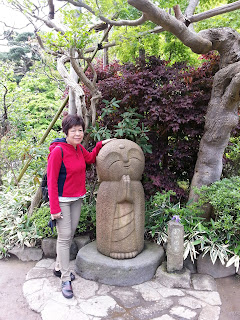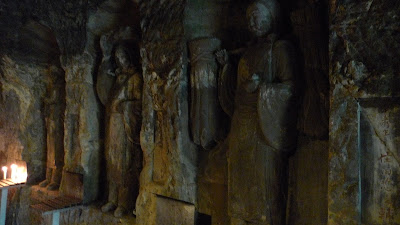BIG BUDDHA
To fuel up for another long day.....
Walking from train station, its a bright and beautiful day....
No rewards for guessing right what this shop is selling
the way to the Great Kannon....
There is a musical box shop, .....no photographs allowed inside though..
This Chinese Juniper tree is 730 years old..
The twisted trunk of the a camphor tree.
The guide told us that the founder of Hasedera temple had carved out a pair of Kannon statue from a block of camphor. One of the statue was sent out the sea with prayers to help ease the sufferings of mankind. The wooden Kannon statue was found washed up on the beach and this became the site of the temple. The other statue is the Kannon at Nara.
The gardens at Hasedera Temple are gorgeous!
cleansing before entering..
the 3 jizo stones
mossy grounds and this garden is also famous for the hydrangeas in summer.
In the past the expecting mothers put these statues to pray for safe delivery but nowadays these jizo stones are offered for the souls of unborn children.
the wisteria plant
We soon made our way up here ... an observation deck
A skewer of dango mochi, a Japanese dumpling and sweet made from rice flour and a steamed pau bought from the observation deck shop.
the panoramic of bay view from the observation deck...
the Bellfry
The Prayer Wheel house.
This giant prayer wheel is made of wood built without nails and in the center are housed the thousands of sutras. Prayers wheels are common in Tibetan Buddhism and where spinning a wheel has the same effect of saying a prayer itself.
The words usually inscribed on these wheels contain the mantra Om Mani Padme Hu and here the visitors can rotate these wheels which are on the side walls
the bamboo grove behind the temple...
a torii before the entrance to the....
Benten Kutsu Cave, a series of tunnels and small caves dedicated to the Bentzaiten, a Japanese Shinto deity, a sea goddess and music and she is shown with a traditional Japanese lute.
It was cool and dark inside, the only lighting was from the candles placed in front of the gods which have been carved in the wall of the caves.
It was good to be out in the open space again. We walked towards the Kotoku-in Temple where the Kamakura Daibutsu (Great Buddha) sit.
Daibutsu... its height 37 feet and weighs 121 ton bronze status of Buddha constructed in 1252.
the mystical aura and impace of Daibutsu with dyani mudra hands (meditation position) eyes closed but all seeing and head bowed can be felt upclose.
One of the Lotus Petal statue in front of Daibutsu.
The guide told us that the first Buddha built was actually of wood but it was destroyed in a storm and was replaced by this bronze Buddha in 1252 inside a temple hall. The temple hall was again damaged by storm in 13th century and rebuilt, then it was washed completely away by tsunami in 14th century. Since then the Daibutsu has been exposed outdoors with ongoing repairs being carried out to preserve it.
the statue is hollow and visitors can enter to view from the "windows" (eye).
"Stranger, whosoever thou art and whatsoever be thy creed, when thou enterest this sanctuary remember thou treadest upon ground hallowed by the worship of ages. This is the Temple of Bhudda and the gate of the eternal, and should therefore be entered with reverence."
As we were walking towards the temple, we saw a bridal procession along the road...
Kamakura is famous for fresh Shirasu sashimi.
Shirasu is small sardine or whitebait and either served raw with soy sauce or fried with other seafood in omelette and served with rice(shirasu don) or ramen. Taste slightly chewy but no fishy smell, but I cannot bear looking at those tiny eyes staring at you!LOL
The Shrine of Tsurugaoka Hachimangu can be seen from this point and the old bridge entrance which is closed. It is the most important shrine in Kamakura and was moved to this site by Minamoto Yoritomo in 1180 the founder and shogun of the Kamakura government. The Shrine was dedicated to Hachiman, the Shinto god of war.
A paid of newly wedded departing from the temple, must be a good day to be married because inside the shrine, there were another bridal party......
Fried Gingko... slightly bitter taste
The remains of the 1000 years old gingko tree which did not survived a storm in 2010. The 3rd Kamakura Shogun was assassinated in 1219 by an archer hiding before this gingko tree. A new tree has been planted next to it. The shrine is located at the top of 62 steps staircase.
The lower worship hall where many rituals and dedicatory dances and music are performed.
Later after the prayers and blessings, there was a dance performance by a female priestess, no photographs allowed.
In the courtyard, there are these round barrels displayed. These are casks of sake given in offering to the shrine during the rituals/festivals at the shrine.
Ramen dinner again...
one of road side shrine around the hotel.

























































I visited Kamakura too and posted so few photos with little write ups. I salute all your information and lovely photos. I actually learnt some new facts from you,thanks to your good tour guide!
ReplyDeleteYes, the Tokyo guide is very informative, he has been staying in Japan for more than 10 years. In fact Wendy Tours is among the top agents in Japan.
ReplyDelete